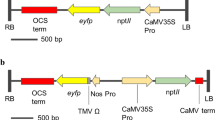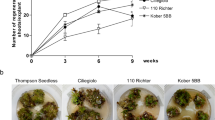Abstract
Most cultivars of higher plants display poor regeneration capacity of explants due to yet unknown genotypic determined mechanisms. This implies that technologies such as transformation often are restricted to model cultivars with good tissue characteristics. In the present paper, we add further evidence to our previous hypothesis that regeneration from young barley embryos derived from in vitro-cultured ovules is genotype independent. We investigated the ovule culture ability of four cultivars Femina, Salome, Corniche and Alexis, known to have poor response in other types of tissue culture, and compared that to the data for the model cultivar, Golden Promise. Subsequently, we analyzed the transformation efficiencies of the four cultivars using the protocol for Agrobacterium infection of ovules, previously developed for Golden Promise. Agrobacterium tumefaciens strain AGL0, carrying the binary vector pVec8-GFP harboring a hygromycin resistance gene and the green fluorescence protein (GFP) gene, was used for transformation. The results strongly indicate that the tissue culture response level in ovule culture is genotype independent. However, we did observe differences between cultivars with respect to frequencies of GFP-expressing embryos and frequencies of regeneration from the GFP-expressing embryos under hygromycin selection. The final frequencies of transformed plants per ovule were lower for the four cultivars than that for Golden Promise but the differences were not statistically significant. We conclude that ovule culture transformation can be used successfully to transform cultivars other than Golden Promise. Similar to that observed for Golden Promise, the ovule culture technique allows for the rapid and direct generation of high quality transgenic plants.


Similar content being viewed by others
Abbreviations
- BAP :
-
Benzylaminopurine
- GFP :
-
Green fluorescence protein
- nos :
-
Nopaline synthase
References
Bailey MA, Boerma HR, Parrott WA (1994) Inheritance of Agrobacterium tumefaciens-induced tumorigenesis of soybean. Crop Sci 34:514–519
Barro F, Martin A, Lazzeri PA, Barcelo P (1999) Medium optimization for efficient somatic embryogenesis and plant regeneration from immature inflorescences and immature scutella of elite cultivars of wheat, barley and tritordeum. Euphytica 108:161–167. doi:10.1023/A:1003676830857
Bregitzer P (1992) Plant regeneration and callus type in barley: effect of genotype and culture medium. Crop Sci 32:1108–1112
Bregitzer P, Tonks D (2003) Inheritance and expression of transgenes in barley. Crop Sci 43:4–12
Bregitzer P, Halbert SE, Lemaux PG (1998) Somaclonal variation in the progeny of transgenic barley. Theor Appl Genet 96:421–425. doi:10.1007/s001220050758
Brinch-Pedersen H, Olesen A, Rasmussen SK, Holm PB (2000) Generation of transgenic wheat (Triticum aestivum L.) for constitutive accumulation of an Aspergillus phytase. Mol Breed 6:195–206. doi:10.1023/A:1009690730620
Castillo AM, Egaña B, Sanz JM, Cistué L (1998) Somatic embryogenesis and plant regeneration from barley cultivars grown in Spain. Plant Cell Rep 17:902–906. doi:10.1007/s002990050506
Cheng M, Fry JE, Pang SZ, Zhou HP, Hironaka CM, Duncan DR, Conner TW, Wan YC (1997) Genetic transformation of wheat mediated by Agrobacterium tumefaciens. Plant Physiol 115:971–980
Cho M-J, Jiang W, Lemaux PG (1998) Transformation of recalcitrant barley cultivars through improvement of regenerability and decreased albinism. Plant Sci 138:229–244. doi:10.1016/S0165-1781(98)00122-X
Choi HW, Lemaux PG, Cho MJ (2000) Increased chromosomal variation in transgenic versus nontransgenic barley (Hordeum vulgare L.) plants. Crop Sci 40:524–533
Christou P, Ford TL, Kofron M (1991) Production of transgenic rice (Oryza sativa L) plants from agronomically important Indica and Japonica varieties via electric-discharge particle-acceleration of exogenous DNA into immature zygotic embryos. Biotechnology 9:957–962
Dahleen LS, Bregitzer P (2002) An improved media system for high regeneration rates from barley immature embryo-derived callus cultures of commercial cultivars. Crop Sci 42:934–938
Fromm ME, Morrish F, Armstrong C, Williams R, Thomas J, Klein TM (1990) Inheritance and expression of chimeric genes in the progeny of transgenic maize plants. Biotechnology 8:833–839
Gelvin SB (2003) Improving plant genetic engineering by manipulating the host. Trends Biotechnol 21:95–98. doi:10.1016/S0167-7799(03)00005-2
Hensel G, Valkov V, Middlefell-Williams J, Kumlehn J (2008) Efficient generation of transgenic barley: the way forward to modulate plant–microbe interactions. J Plant Physiol 165:71–82. doi:10.1016/j.jplph.2007.06.015
Hiei Y, Ohta S, Komari T, Kumashiro T (1994) Efficient transformation of rice (Oryza sativa L) mediated by Agrobacterium and sequence-analysis of the boundaries of the T-DNA. Plant J 6:271–282. doi:10.1046/j.1365-313X.1994.6020271.x
Holm PB, Knudsen S, Mouritzen P, Negri D, Olsen FL, Roue C (1995) Regeneration of the barley zygote in ovule culture. Sex Plant Reprod 8:49–59
Holme IB, Brinch-Pedersen H, Lange M, Holm PB (2006) Transformation of barley (Hordeum vulgare L.) by Agrobacterium tumefaciens infection of in vitro cultured ovules. Plant Cell Rep 25:1325–1335. doi:10.1007/s00299-006-0188-4
Ishida Y, Saito H, Ohta S, Hiei Y, Komari T, Kumashiro T (1996) High efficiency transformation of maize (Zea mays L.) mediated by Agrobacterium tumefaciens. Nat Biotechnol 14:745–750. doi:10.1038/nbt0696-745
Kaeppler SM, Kaeppler HF, Rhee Y (2000) Epigenetic aspects of somaclonal variation in plants. Plant Mol Biol 43:179–188. doi:10.1023/A:1006423110134
Koprek T, Hänsch R, Nerlich A, Mendel RR, Schulze J (1996) Fertile transgenic barley of different cultivars obtained by adjustment of bombardment conditions to tissue response. Plant Sci 119:79–91. doi:10.1016/0168-9452(96)04445-7
Kumlehn J, Serazetdinova L, Hensel G, Becker D, Loerz H (2006) Genetic transformation of barley (Hordeum vulgare L.) via infection of androgenetic pollen cultures with Agrobacterium tumefaciens. Plant Biotechnol J 4:251–261. doi:10.1111/j.1467-7652.2005.00178.x
Lazo GR, Stein PA, Ludwig RA (1991) A DNA Transformation-competent Arabidopsis genomic library in Agrobacterium. Biotechnology 9:963–967
Manoharan M, Dahleen LS (2002) Genetic transformation of the commercial barley (Hordeum vulgare L.) cultivar Conlon by particle bombardment of callus. Plant Cell Rep 21:76–80. doi:10.1007/s00299-002-0477-5
Mauro AO, Pfeiffer TW, Collins GB (1995) Inheritance of soybean susceptibility to Agrobacterium tumefaciens and its relationship to transformation. Crop Sci 35:1152–1156
Mouritzen P, Holm PB (1994) Chloroplast genome breakdown in microspore cultures of barley (Hordeum vulgare L) occurs primarily during regeneration. J Plant Physiol 144:586–593
Murray F, Brettell R, Matthews P, Bishop D, Jacobsen J (2004) Comparison of Agrobacterium-mediated transformation of four barley cultivars using the GFP and GUS reporter genes. Plant Cell Rep 22:397–402. doi:10.1007/s00299-003-0704-8
Mysore KS, Nam J, Gelvin SB (2000) An Arabidopsis histone H2A mutant is deficient in Agrobacterium T-DNA integration. Proc Natl Sci USA 97:948–953
Nam J, Matthysse AG, Gelvin SB (1997) Differences in susceptibility of Arabidopsis ecotypes to crown gall disease may result from a deficiency in T-DNA integration. Plant Cell 9:317–333
Owens LD, Cress DE (1985) Genotypic variability of soybean response to Agrobacterium strains harbouring the Ti or Ri plasmids. Plant Physiol 77:87–94
Robbs SL, Hawes MC, Lin H-J, Pueppke SG, Smith LY (1991) Inheritance of resistance to crown gall in Pisum sativum. Plant Physiol 95:52–57
SAS Institute Inc. (1993) SAS Technical Report P-23. SAS/STAT Software. The GENMOD Procedure. Release 6.09. SAS Institute Inc. Cary, NC, p 88
Sharma VK, Hänsch R, Mendel RR, Schulze J (2005) Mature embryo axis-based high frequency somatic embryogenesis and plant regeneration from multiple cultivars of barley (Hordeum vulgare L). J Exp Bot 56:1913–1922. doi:10.1093/jxb/eri186
Sparrow PAC, Townsend TM, Arthur AE, Dale PJ, Irwin JA (2004) Genetic analysis of Agrobacterium tumefaciens susceptibility in Brassica oleracea. Theor Appl Genet 108:644–650. doi:10.1007/s00122-033-1473-z
Szegedi E, Kozma P (1984) Studies on the inheritance of resistance to crown gall disease of grapevine. Vitis 23:121–126
Tingay S, McElroy D, Kalla R, Fieg S, Wang MB, Thornton S, Brettell R (1997) Agrobacterium tumefaciens-mediated barley transformation. Plant J 11:1369–1376. doi:10.1046/j.1365-313X.1997.11061369.x
Trifonova A, Madsen S, Olesen A (2001) Agrobacterium-mediated transgene delivery and integration into barley under a range of in vitro culture conditions. Plant Sci 161:871–880. doi:10.1016/S0168-9452(01)00479-4
Vashney A, Altpeter F (2001) Stable transformation and tissue culture response in current European winter wheats (Triticum aestivum L.). Mol Breed 8:295–309. doi:10.1023/A:1015240901016
Vasil V, Castillo AM, Fromm ME, Vasil IK (1992) Herbicide resistant fertile transgenic wheat plants obtained by microprojectile bombardment of regenerable embryogenic callus. Biotechnology 10:667–674
Veena HJ, Doerge RW, Gelvin SB (2003) Transfer of T-DNA and Vir proteins to plant cells by Agrobacterium tumefaciens induces expression of host genes involved in mediating transformation and suppresses host gene expression. Plant J 35:219–236. doi:10.1046/j.1365-313X.2003.01796.x
Wan YC, Lemaux PG (1994) Generation of large numbers of independently transformed fertile barley plants. Plant Physiol 104:37–48
Wang M-B, Abbott DC, Upadhyaya NM, Jacobsen JV, Waterhouse PM (2001) Agrobacterium tumefaciens-mediated transformation of an elite Australian barley cultivar with virus resistance and reporter genes. Aust J Plant Physiol 28:149–156. doi:10.1071/PP00103
Yi HC, Mysore KS, Gelvin SB (2002) Expression of the Arabidopsis histone H2A-1 gene correlates with susceptibility to Agrobacterium transformation. Plant J 32:285–298. doi:10.1046/j.1365-313X.2002.01425.x
Acknowledgments
The authors thank Ole Bråd Hansen and Lis Bagnkop Holte for skilful technical assistance. The work was funded by grant 23-02-0019 from the Danish Research Council for Technology and Production Sciences.
Author information
Authors and Affiliations
Corresponding author
Additional information
Communicated by W. Harwood.
Rights and permissions
About this article
Cite this article
Holme, I.B., Brinch-Pedersen, H., Lange, M. et al. Transformation of different barley (Hordeum vulgare L.) cultivars by Agrobacterium tumefaciens infection of in vitro cultured ovules. Plant Cell Rep 27, 1833–1840 (2008). https://doi.org/10.1007/s00299-008-0605-y
Received:
Revised:
Accepted:
Published:
Issue Date:
DOI: https://doi.org/10.1007/s00299-008-0605-y




